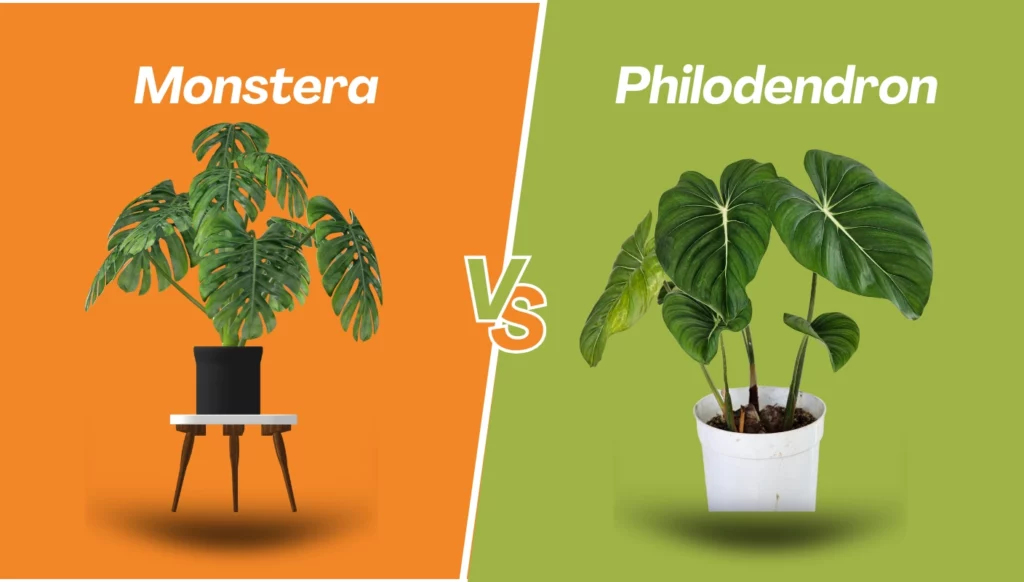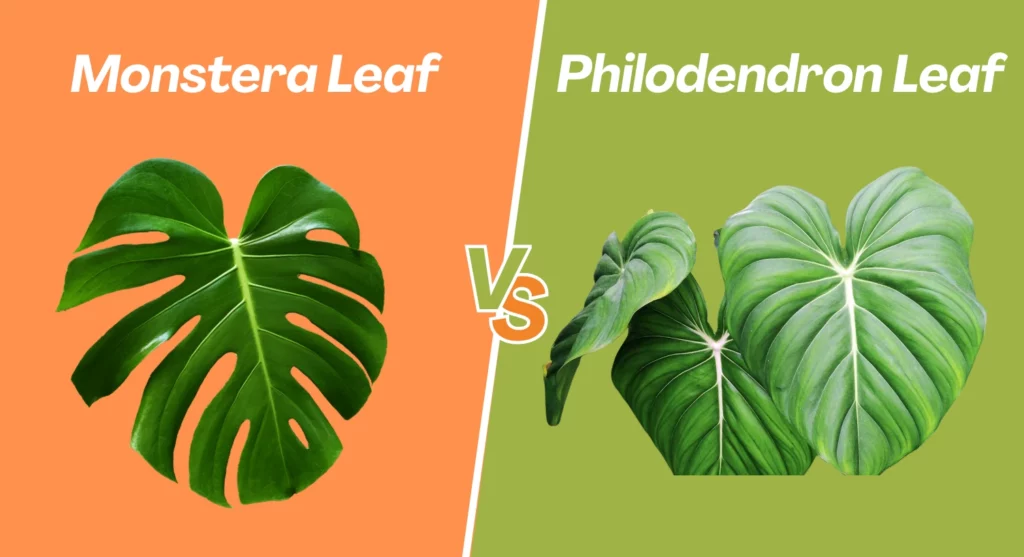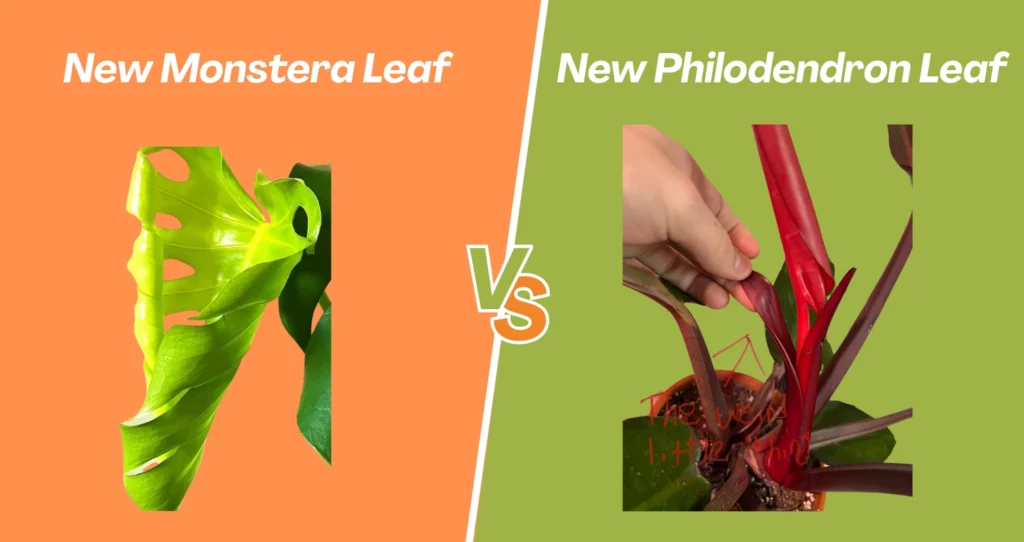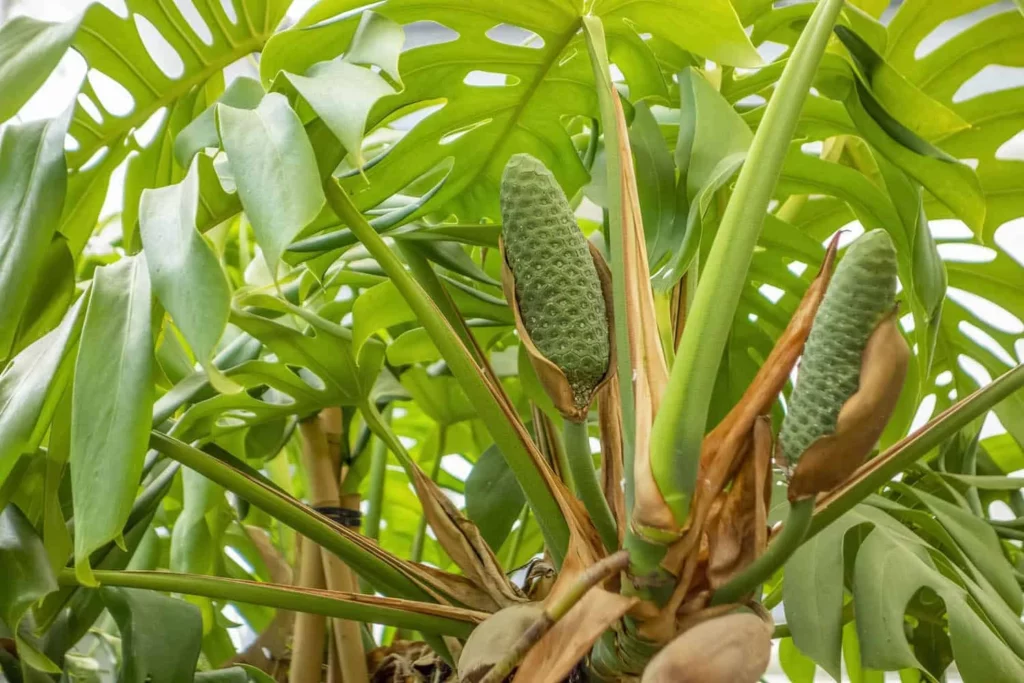
Many plant lovers mix up Monstera and Philodendron, and it’s easy to see why. They both have large tropical leaves, climb with aerial roots, and thrive in similar indoor conditions. In this Monstera vs Philodendron guide, you’ll learn how to spot key differences in leaf shape, growth style, and care needs. Whether you’re trying to ID your plant or decide which one to bring home, this article gives you a clear side-by-side comparison. Let’s see!
Why Monstera and Philodendron Are So Easy to Confuse?
These two plants look almost identical at first glance. Both come from the same plant family (Araceae), grow in similar tropical climates, and have big green leaves that split as they mature.
That’s why a split leaf Monstera vs Philodendron mix-up is so typical, especially in plant stores, where labels aren’t always accurate. The key issue is that they share the same “jungle look,” but they’re not the same plant. If you’ve ever bought one and weren’t sure what it was, you’re definitely not alone.
Key Similarities Between Monstera and Philodendron
It’s no surprise that people compare the Monstera vs Philodendron. They share a lot of traits, mainly when grown indoors:
- Both are aroids with aerial roots, meaning they can climb or trail when given support
- Both have large, heart-shaped leaves, though Monstera’s develop holes and Philodendron’s stay solid or split
- Both thrive in bright, indirect light and enjoy warm, humid conditions
- Both are considered easy-care houseplants, perfect for beginners looking for tropical vibes without too much maintenance
Main Differences: Monstera vs Philodendron
Although Monstera vs Philodendron share similar tropical looks, they’re very different plants once you take a closer look. Their leaves may seem alike, especially when young, but their structure, growth behavior, and care traits reveal distinct identities. Let’s see where they differ.
Leaf Shape and Texture

Monstera (especially Monstera deliciosa) develops large, glossy green leaves with deep lobes and unique fenestrations, or holes. These holes start forming as the plant matures and are thought to help light filter through to lower leaves in a dense jungle setting. Monstera leaves also have a waxy, smooth feel and a more dramatic, sculptural look.
Philodendron, depending on the variety (especially Philodendron bipinnatifidum or selloum), may have deeply split or lobed leaves, but they don’t develop holes. The texture is typically more leathery and matte, and some species have reddish or bronze-toned undersides, which Monstera never do.
If you’re trying to compare split leaf Philodendron vs Monstera Deliciosa, the easiest giveaway is the holes: Monstera has them, Philodendron doesn’t.
Growth Habit
Monstera is a slow but steady climber. It prefers to grow vertically, often anchoring itself with aerial roots onto a moss pole or tree in the wild. Indoors, it can grow about 1–2 feet per year with good care. Its upright structure and predictable pace make it a favorite for vertical displays and statement corners.
Philodendron grows faster and more flexibly. It can climb like a Monstera, but it also grows outward in a bushy or trailing manner, depending on the type. Some even grow in tree-like forms. It tends to spread wide rather than tall, making it ideal for hanging baskets or shelf edges.
This means that in a Monstera vs Philodendron choice, Monstera suits vertical spaces, while Philodendron fills horizontal gaps quickly.
New Leaf Growth

Monstera leaves emerge as a tight curl and unfurl naturally over time, without any outer protection. It’s a clean and simple process that results in beautifully smooth young leaves.
Philodendron, on the other hand, produces new leaves inside a cataphyll, a papery sheath that protects the leaf as it grows. Once the leaf emerges, this sheath dries up and falls off. It’s a slight difference, but noticeable if you watch your plant closely.
Fruit and Flowers
Monstera deliciosa is capable of producing an edible fruit in its natural environment or greenhouses. It looks like a green corn cob covered in hexagonal scales and has a sweet, pineapple-like flavor when ripe (though it can be irritating if eaten unripe).

Philodendron plants don’t produce edible fruit at all. Some may flower under ideal conditions, but fruiting is not part of their profile. While this trait doesn’t matter much for casual houseplant owners, it’s an essential distinction in botanical terms.
Toxicity
Lastly, both plants are toxic, but Monstera has a stronger effect.
Monstera contains calcium oxalate crystals, which can cause intense irritation in the mouth and stomach if ingested by pets or humans. Even the sap can cause skin reactions in some people.
Philodendron is also toxic for the same reason, but usually causes milder symptoms. That said, both plants should be kept out of reach of pets and small children.
Quick Comparison Table
| Feature | Monstera | Philodendron |
| Leaf Texture | Glossy, smooth with fenestrations | Leathery, matte, split but no holes |
| Growth Pattern | Upright climber, slow growth | Fast-growing, spreads or trails |
| New Leaf Behavior | Unfurls naturally | Grows in a protective cataphyll |
| Fruit Production | Yes (rare indoors, edible if ripe) | No fruit production |
| Toxicity | Toxic, stronger irritation | Toxic, milder symptoms |
Care Guide Comparison
Caring for a Monstera vs Philodendron is generally low-maintenance, but each plant has its quirks. Take a look at my guide to get more insights.
Light and Water
Monstera loves bright, indirect light. Too much direct sun can scorch the leaves, while too little light can prevent those iconic holes (fenestrations) from forming. It’s also quite forgiving if you forget to water from time to time, as it tolerates light drying between waterings.
Philodendron, on the other hand, is more adaptable to various lighting conditions. It can handle lower light conditions, which makes it ideal for darker rooms or offices. However, it prefers consistently moist soil — not soggy, but it won’t be happy if it dries out completely.
In the Monstera vs Philodendron care debate, light needs are similar, but watering routines differ.
Growth and Repotting
Monstera grows more slowly and steadily. You’ll typically need to repot every 2–3 years, depending on how root-bound the plant becomes. Its root system is strong but not aggressive, so it doesn’t mind staying in the same pot for a while.
Philodendron grows faster, especially in warm, humid conditions. That means it often needs repotting more frequently, every 1 to 2 years, so its roots don’t outgrow the pot too quickly or become crowded.
Common Issues
Monstera is known for its dramatic leaf holes, but if they’re missing or barely visible, it’s usually a sign of insufficient light. Moving it closer to a window or increasing indirect sunlight can encourage fenestration.
Philodendron is more prone to wilting, which can mean one of two things: the soil is too dry, or the plant is root-bound. If watering doesn’t perk it up, check the roots. Repotting might be overdue.
Final Thoughts
Hope this detailed guide will help you clear up any confusion between Monstera vs Philodendron. The differences are small but noticeable when you know where to look. If you want quick answers on the go, the Planteyes app can help identify your plant in seconds.
FAQs
Is a split-leaf Philodendron the same as a Monstera?
No. The plant often labeled as “split-leaf Philodendron” in stores is actually Monstera deliciosa. True Philodendrons don’t develop holes, only deep splits, and belong to a different genus.
How do I know if my plant will get holes in its leaves?
If it’s a Monstera deliciosa and gets enough bright, indirect light, it will likely develop holes (called fenestrations) as it matures. Philodendrons, even split-leaf types, do not form holes, only lobes or cuts.
Is there an app that can tell me if I have a Monstera or a Philodendron?
Yes, plant ID apps like Planteyes can help identify whether your plant is a Monstera or a Philodendron. Just upload a clear photo of the leaf, and the app will compare it to its database to give you a likely match.
Can a Philodendron grow as big as a Monstera?
Some Philodendron varieties can grow quite large, but in general, Monstera deliciosa tends to grow taller and have larger leaves. Monstera can reach over 10 feet tall indoors with proper support.
Do both plants purify the air?
Yes, both Monstera and Philodendron can help purify the air by removing certain toxins, according to NASA’s Clean Air Study. However, they should not be relied on as primary air purifiers.


